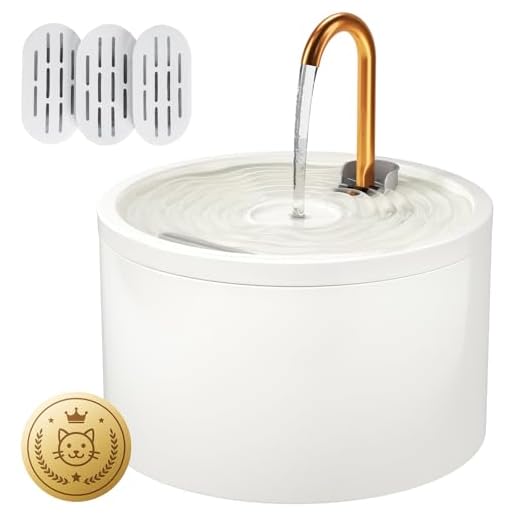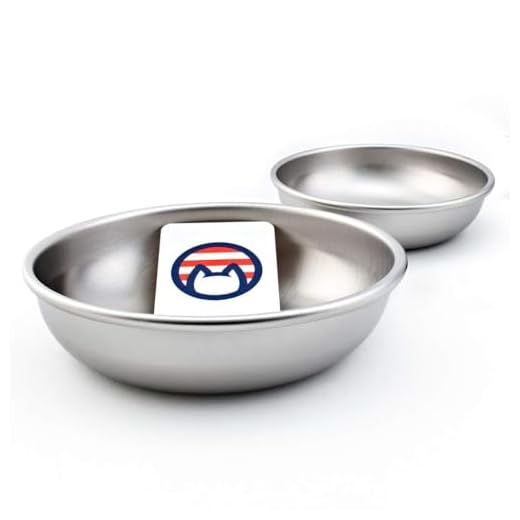



Opting for a stainless steel or ceramic dish is a smart choice for ensuring hydration for your pet. These materials are durable, easy to clean, and less likely to harbor bacteria compared to plastic options. This article provides insights into various designs and features to consider when selecting the ideal drinking container for your furry companion.
This piece is tailored for cat owners seeking practical advice on enhancing their pets’ drinking experience. By evaluating factors such as size, shape, and additional functionalities, you’ll be equipped to make an informed decision that caters to your pet’s preferences.
You’ll find a summary of the pros and cons of different materials and designs, along with tips on maintaining cleanliness and encouraging regular drinking habits. Understanding your pet’s behavior can greatly influence your choice, helping to ensure they stay hydrated and healthy.
Best Type of Water Bowl for Cats
The ideal container for hydration should be made of stainless steel, ceramic, or glass. These materials are durable and easy to clean, ensuring that your pet has access to fresh and safe drinking options.
Both size and depth play a significant role in comfort. A wider design allows for easier access, while a shallow basin can prevent whisker fatigue, making it more comfortable for your feline friend to drink.
Additional Features to Consider
- Non-Slip Base: A sturdy base prevents spills and keeps the bowl in place during use.
- Elevated Design: Elevated containers can be more comfortable for older or arthritic pets.
- Water Fountain: Continuous flow can attract some cats to drink more, helping with hydration.
Regular maintenance is crucial. Clean the bowl daily to prevent bacterial growth. Consider using a dishwasher-safe option for convenience.
Monitor your pet’s drinking habits. If you notice a decrease in water intake, it may be necessary to explore other styles or materials to ensure they remain hydrated.
Material Choices: Plastic vs. Ceramic vs. Stainless Steel
Choosing the right vessel for hydration involves understanding the benefits and drawbacks of various materials. Plastic, ceramic, and stainless steel each present unique characteristics that can influence your decision.
Plastic options are lightweight and less likely to break, making them a convenient choice for pet owners. However, they can absorb odors and stains over time, which may deter some from selecting this material. Additionally, some plastics contain harmful chemicals like BPA, which can leach into the liquid.
Comparative Analysis
On the other hand, ceramic containers offer a more aesthetically pleasing look and are often heavier, reducing the risk of tipping. They do not retain odors and are typically dishwasher safe. Yet, they can chip or crack if dropped, which may lead to safety concerns.
Stainless steel is known for its durability and resistance to rust and corrosion. This material is non-porous and does not retain odors, making it easy to clean. It is less likely to tip over due to its weight and is often dishwasher safe. Nevertheless, some pets may find stainless steel less appealing due to the cooler temperature it maintains.
| Material | Advantages | Disadvantages |
|---|---|---|
| Plastic | Lightweight, affordable | Can absorb odors, may contain harmful chemicals |
| Ceramic | Attractive, heavy, odor-resistant | Can chip or crack |
| Stainless Steel | Durable, easy to clean, non-porous | May be less appealing to some pets |
Ultimately, the choice of material should reflect both the preferences of the pet and the practical considerations of the pet owner. Assessing the environment and the individual needs can guide a more informed selection.
Size and Shape: Finding the Right Fit for Your Cat
Choosing the appropriate dimensions and configuration for a water receptacle can significantly influence your feline’s hydration habits. A vessel that is too deep or narrow may deter your pet from drinking, while one that is too shallow can lead to spills and mess.
Typically, a dish with a wide, shallow basin allows for easy access and encourages frequent sips. Cats prefer to see their surroundings while drinking, so an open design can enhance their comfort level and promote hydration.
Considerations for Size
When selecting a container, it’s important to think about your cat’s size and drinking style. Larger breeds might require a more spacious design, while smaller ones may be comfortable with a more compact option. Regularly assess the water level to ensure that it’s suitable for your pet’s needs.
Shape Variations
The configuration of the receptacle can also play a role in your cat’s preferences. For example, round shapes are often favored since they allow easy access from various angles. Some cats might appreciate more angular designs, which can fit into corners or specific spaces in your home.
As you explore options, consider the following:
- Wide bases to prevent tipping
- Low edges for easy access
- Stable constructions to avoid spills
Experimenting with different sizes and shapes can help you discover what works best for your pet, ensuring they remain well-hydrated and healthy.
Automated Water Dispensers: Pros and Cons
Automated dispensers offer a convenient solution for providing hydration to pets, ensuring a continuous supply of fresh liquid. These devices can help maintain the quality of water, reducing the risk of contamination and encouraging pets to drink more.
However, there are drawbacks to consider. Maintenance requirements can be higher than traditional options. Regular cleaning and monitoring of the device are essential to prevent malfunction and ensure safe drinking conditions.
Advantages
- Continuous Flow: These units often have a filtration system that keeps the liquid fresh, appealing to pets that prefer running water.
- Encouragement to Hydrate: Motion and sound can entice pets to drink more frequently, promoting better hydration.
- Convenience: Reduced need for daily refilling makes them suitable for busy pet owners.
Disadvantages
- Complexity: Mechanical components may fail, requiring repairs or replacement.
- Noise: Some models can be noisy, which may deter sensitive pets.
- Initial Cost: The investment can be higher compared to simple bowls, impacting budget-conscious owners.
In conclusion, automated dispensers can enhance hydration habits in pets while offering convenience for owners. However, the need for regular upkeep and potential mechanical issues should be weighed against their advantages.
Design Features That Encourage Hydration
Selecting a suitable container for your feline companion involves understanding the design elements that promote regular drinking habits. Enhanced aesthetics and functionality can significantly influence your pet’s willingness to hydrate.
One effective feature is the incorporation of a wide, shallow shape. This design minimizes the risk of whisker fatigue, a common issue that can discourage cats from accessing water comfortably. A stable base is also essential to prevent spills and maintain cleanliness around the area.
Additional Features to Consider
- Movement and Flow: Water that circulates can attract cats, as they are instinctively drawn to fresh sources. A gentle fountain mechanism can stimulate their interest.
- Material: Non-porous materials, such as stainless steel or ceramic, are preferable. They do not retain odors and are easier to clean, ensuring a hygienic drinking environment.
- Size: A larger capacity reduces the frequency of refills, making it easier to maintain fresh water availability.
- Height: Elevated designs can be more comfortable for some cats, reducing strain on their necks while drinking.
Considering these design elements can lead to better hydration habits in your pet. By creating an inviting drinking space, you can contribute to your cat’s overall health and well-being.
Cleaning and Maintenance Tips for Cat Water Bowls
Regular cleaning is necessary to prevent bacteria growth and keep your feline hydrated. Use warm, soapy water to scrub the container thoroughly at least once a week. For deeper cleaning, consider a mixture of white vinegar and water, which helps eliminate mineral deposits.
Replace the liquid daily to ensure freshness. If your pet has long whiskers, opt for a wider vessel to prevent whisker fatigue. Monitor for scratches or cracks, as these can harbor bacteria.
Maintenance Schedule
- Daily: Change the liquid and rinse the dish.
- Weekly: Scrub with soap and warm water.
- Monthly: Inspect for damage and deep clean with vinegar solution.
Consider using a dishwasher-safe container for easier maintenance. If you use a fountain, clean the pump and filter according to the manufacturer’s instructions to ensure it runs smoothly.
Pay attention to your furry friend’s drinking habits. If you notice a change, it may indicate issues with the container or the quality of the liquid. Keeping the drinking area tidy will encourage proper hydration.
Best type of water bowl for cats
Features
| Part Number | 4334681236 |
| Model | 4334681236 |
| Color | Brushed Stainless Steel |
| Size | 2 Bowls |
Features
| Part Number | S001 |
| Model | S001 |
| Warranty | 1 Year Warranty |
| Color | White |
Features
| Part Number | S001 |
| Model | S001 |
| Color | White |
| Is Adult Product |
Features
| Part Number | PLWF105 |
| Model | PLWF105 |
| Warranty | 24 Months |
| Color | Black |
| Is Adult Product | |
| Release Date | 2023-09-28T00:00:01Z |
| Size | Fountain |
Features
| Model | Potaroma-CWYSJ |
| Warranty | 30 Day Warranty |
| Color | White |
| Size | 3.5L |
Features
| Part Number | PD-412 |
| Model | PD-412 |
| Warranty | One Year Warranty |
| Color | silvery |
Features
| Model | CF1W |
| Color | Black |
Video:
FAQ:
What are the different types of water bowls available for cats?
There are several types of water bowls designed for cats, including ceramic, stainless steel, plastic, and automatic water fountains. Ceramic bowls are often preferred for their aesthetic appeal and ease of cleaning, while stainless steel bowls are durable and resistant to bacteria. Plastic bowls are lightweight and inexpensive but may retain odors over time. Automatic water fountains provide a continuous flow of fresh water, which can encourage cats to drink more.
Why might a cat prefer a water fountain over a traditional bowl?
Cats are often attracted to moving water, as it is instinctually associated with freshness. A water fountain mimics this movement, which can entice a cat to drink more. Additionally, fountains typically filter the water, keeping it clean and free from contaminants. This can be particularly appealing for cats that are sensitive to taste or smell, making them more likely to stay hydrated.
Are there any specific features to look for in a cat water bowl?
When selecting a water bowl for your cat, consider features such as size, stability, material, and ease of cleaning. A non-slip base can prevent spills, while a deeper bowl may suit cats that tend to splash. Look for materials that are safe and durable, like stainless steel or ceramic. Additionally, choose a bowl that is easy to clean, as hygiene is important for your cat’s health.
How can I encourage my cat to drink more water using a bowl?
To encourage your cat to drink more water, consider placing the bowl in a quiet, accessible location away from food and litter boxes. You can also try different types of bowls to see which one your cat prefers. Adding ice cubes or using a water fountain can make the water more appealing. Additionally, ensuring the water is fresh and changed regularly will help maintain your cat’s interest in drinking.










